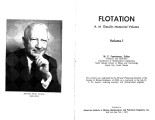Filters: Department: "Metallurgical Engineering" School Or College: "College of Mines & Earth Sciences" Collection: "ir_uspace"
1 - 25 of 10
| Creator | Title | Description | Subject | Date | ||
|---|---|---|---|---|---|---|
| 1 |
 |
Miller, Jan D. | Analysis of the surface potential developed by non-reactive ionic solids | The sign of the surface potential for complex non-reactive ionic solids cannot be predicted solely from consideration of the hydration energy of gaseous ions which constitute the ionic lattice. Accurate analysis of these systems must involve the hydration energy of surface ions, which requires knowl... | Lattice; dipole; Madelung Constants | 1976 |
| 2 |
 |
Miller, Jan D. | Spectroscopic analysis of passivation reactions for carbonaceous matter from carlin trend ores | Abstract. Three different refractory carbonaceous gold ores from the Carlin operation in northeastern Nevada were investigated to characterize the effect of passivation treatments on the nature of the carbonaceous material. The carbonaceous material was chemically isolated from the ores and pass... | Gold; Chlorine; Cyanidation | 1990 |
| 3 |
 |
Miller, Jan D.; Herbst, John A. | Factors affecting droplet size distributions produced in dispersed phase mixers | Droplet size distributions were determined by stabilizing in gelatin and measurement of the distributions by means of computerized image analysis. Several variables that affect droplet sizes were studied and the resulting size distributions were modeled via a population balance equation. Key paramet... | Gelatin; Phases; Agitating | 1981 |
| 4 |
 |
Miller, Jan D.; Yost, Garold S.; Veranth, John M. | Novel method to detect unlabeled inorganic nanoparticles and submicron particles in tissue by sedimentation field-flow fractionation | A novel methodology to detect unlabeled inorganic nanoparticles was experimentally demonstrated using a mixture of nano-sized (70 nm) and submicron (250 nm) silicon dioxide particles added to mammalian tissue. The size and concentration of environmentally relevant inorganic particles in a tissue sa... | Sedimentation field-flow fractionation; Transmission electron microscopy; Tissue digestion | 2008 |
| 5 |
 |
Miller, Jan D.; Wan, Rong Yu | Significance of carbon properties in the enhanced ferric sulfate leaching of CuFeS2/C aggregates | Acid ferric sulfate solution has been used for heap and dump leaching of low-grade chalcopyrite ores and is being considered as a possible lixiviant for the hydrometallurgical processing of copper sulfide concentrates. For many years, researchers have attempted to explain the leaching behavior of ch... | Ferric sulfate; CuFeS2; Particulate carbon | 1984 |
| 6 |
 |
Miller, Jan D. | The behavior of arsenic trioxide in non-ferrous extractive metallurgical processing | Study of the acid bake-leach process has shown potential advantages for the treatment of enargite (Cu3AsS4) concentrates. Among the most important advantages of the process is the transformation of enargite to water-soluble copper sulfate and highly soluble arsenic trioxide (arsenolite). Because ars... | 2014-01-01 | |
| 7 |
 |
Miller, Jan D. | Evaluation of plantwide control strategies for coal preparation plants | The quality of cleaned products from coal preparation plants is often variable due to natural fluctuations in the washability characteristics of the plant feed. To combat this problem, many modern plants have installed on-line analyzers that provide feedback for the real-time control of product q... | Circuit; Yield; Optimization | 2000 |
| 8 |
 |
Miller, Jan D. | Dimethyl ether - a new synthetic fuel commodity and chemical building block | Dimethyl ether (DME) is recognized as a potential next-generation, environmentally benign commodity for energy storage and distribution, as well as a momentous chemical building block. DME can be produced at a competitive price from synthesis gas conveniently generated from a variety of carbon-cont... | Dimethyl ether; DME; Energy carrier; Energy commodity; Diesel fuel | 2005 |
| 9 |
 |
Chandran, Ravi | Evolution of microstructure and phases in in-situ processed Ti-TiB composites containing high volume fractions of TiB whiskers | A series of titanium composites, with varying volume fractions of titanium monoboride (TiB) whiskers, were made by mixing various proportions of titanium (Ti) and titanium diboride (TiB2) powders followed by hot pressing. The phases present were identified by x-ray diffraction. | Morphology; diffraction; relative intensity | 1999 |
| 10 |
 |
Miller, Jan D. | Understanding the role of ion interactions in soluble salt flotation | There is anecdotal evidence for the significant effects of salt ions on the flotation separation of minerals using process water of high salt content. Examples include flotation of soluble salt minerals such as potash, trona and borax in brine solutions. Although some of the effects are expected, so... | 2011-01-01 |
1 - 25 of 10
